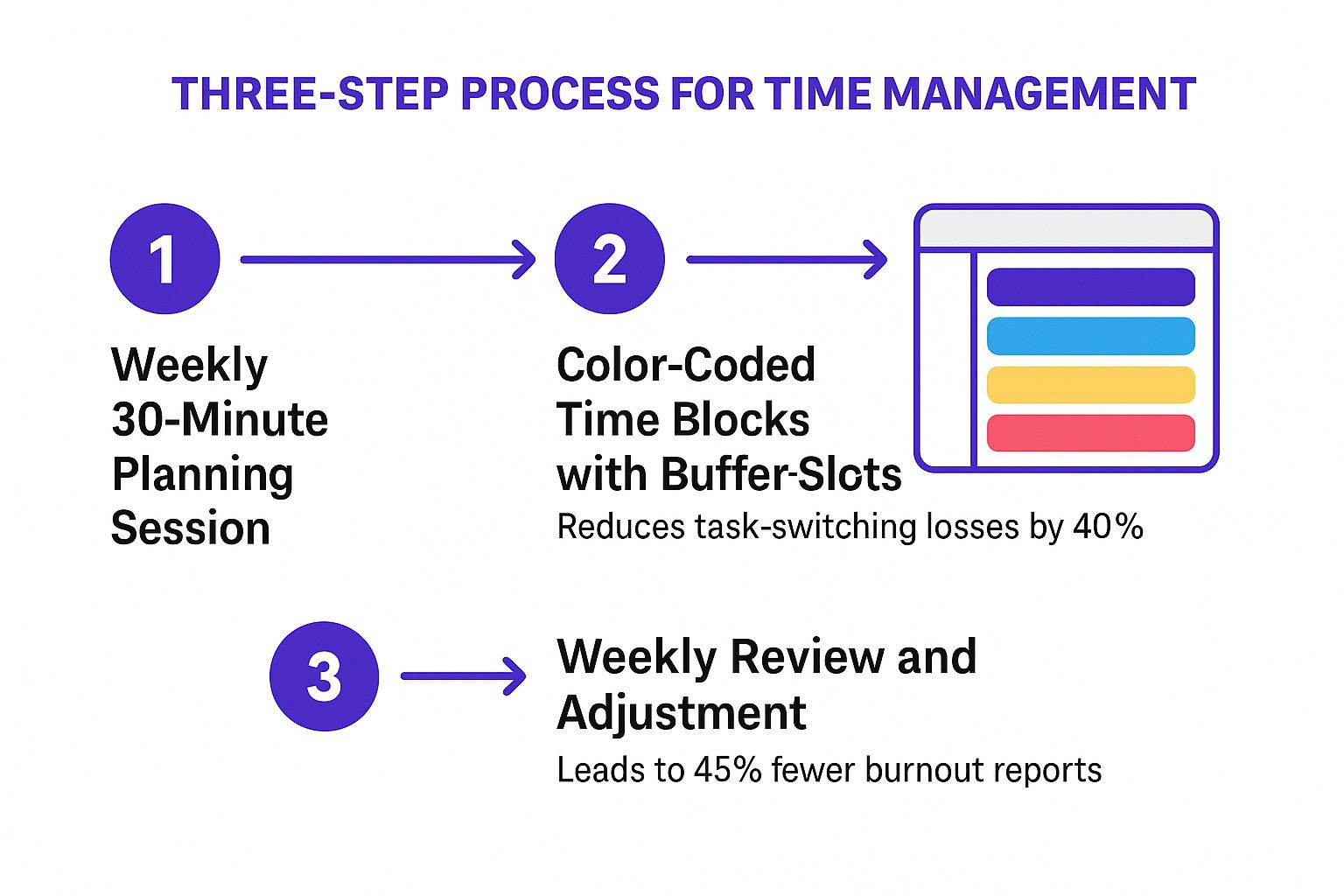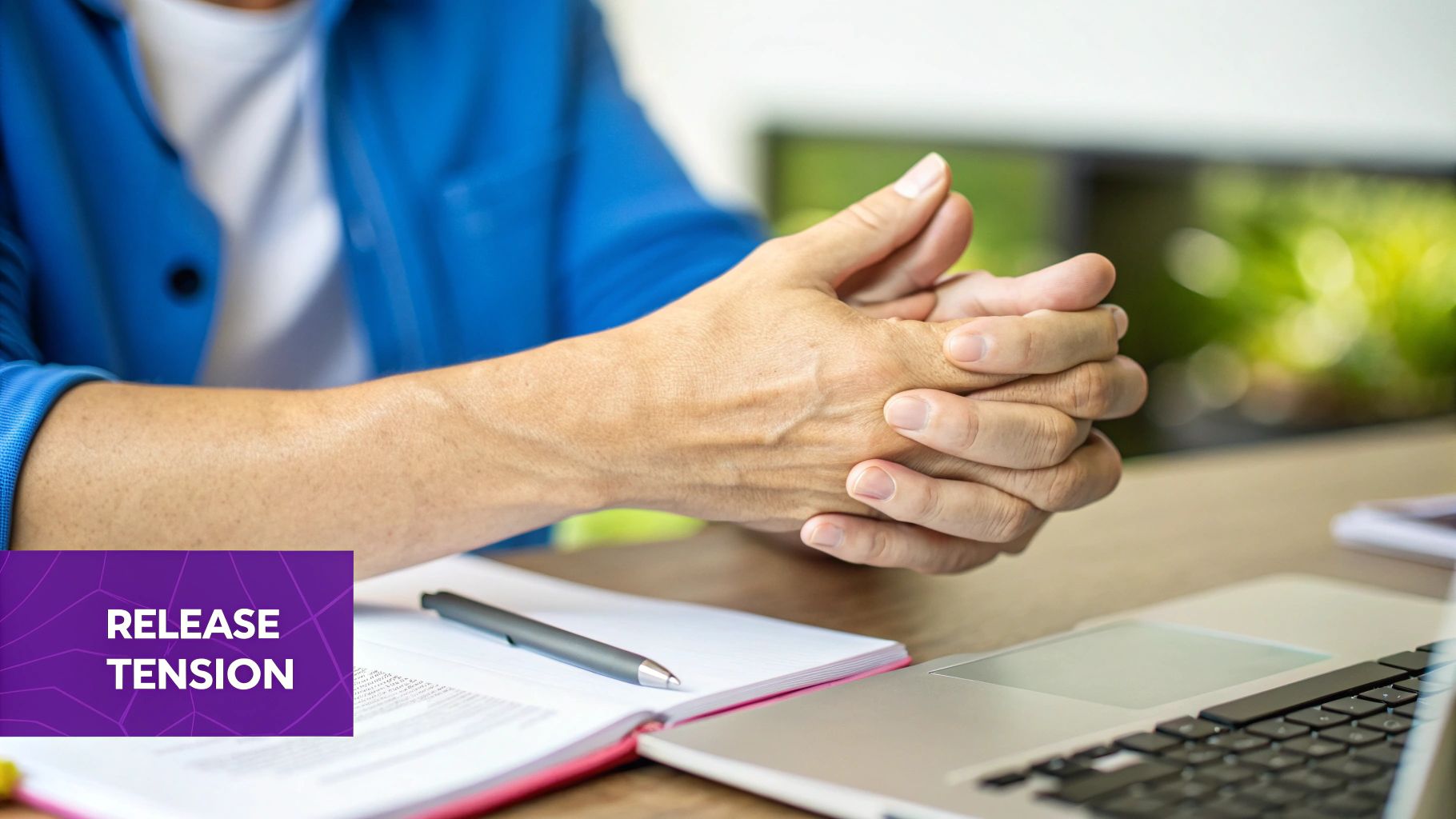8 Essential Workplace Stress Management Techniques for 2025
Workplace stress is more than just a passing bad day; it's a chronic, pervasive challenge that can undermine everything from daily productivity to long-term personal well-being. While common advice often suggests simply "relaxing" or "taking a break," true, lasting relief comes from targeted, evidence-based strategies that directly address the root causes of professional pressure and anxiety. Generic tips fall short because they lack the structure and specificity needed to make a real impact in high-pressure environments.
This guide moves beyond the obvious to provide eight powerful, actionable workplace stress management techniques tailored for the modern professional. Whether you're navigating the complexities of a demanding role, managing the anxieties of a job search, or stepping into your first early-career opportunity, these methods offer practical pathways to build resilience. You will learn how to regain a sense of control and cultivate a healthier, more sustainable relationship with your work.
Instead of abstract concepts, you'll find concrete steps for implementing each technique, from Cognitive Reframing to strategic Time Blocking and effective Boundary Setting. Let's explore the specific, practical tools you can start using today to not just cope with stress, but to actively manage it and thrive in your professional life.
1. Mindfulness Meditation
Mindfulness meditation is a powerful mental training practice that involves focusing your attention on the present moment. By observing your thoughts, feelings, and bodily sensations without judgment, you can break the cycle of rumination and anxiety about past mistakes or future deadlines. This technique fundamentally alters how you relate to stress, making it an essential tool for modern professionals.

The practice trains your brain to respond to stressors more calmly, rather than reacting instinctively. As neuroscientist Dr. Richard Davidson’s research shows, regular meditation can rewire neural pathways, enhancing emotional regulation and focus. This is why leading companies have integrated mindfulness into their corporate wellness strategies. For example, Google's "Search Inside Yourself" program, developed by Chade-Meng Tan, helps thousands of employees build emotional intelligence, while Aetna reported productivity gains of $3,000 per employee after implementing its own programs.
How to Implement Mindfulness at Work
Implementing mindfulness doesn't require a silent retreat or hours of practice. It's about integrating small, consistent moments of awareness into your workday. This approach is one of the most effective workplace stress management techniques because it's accessible and scalable.
- Start Small: Begin with just 2-3 minutes of focused breathing each day. You can do this at your desk before starting a high-stakes task or after a tense meeting.
- Use Guided Apps: Leverage tools like Headspace or Calm for guided sessions during your lunch break. These apps provide structure and make the practice easier for beginners.
- Schedule It: Block off 5-10 minutes in your calendar for meditation, treating it with the same importance as a meeting. Consistency is more important than duration.
- Create a Signal: If you work in an open office, use headphones or a small sign to indicate you need a few moments of quiet without interruption.
- Practice Mindful Moments: Instead of a formal meditation, practice mindfulness while walking to get coffee. Pay attention to the feeling of your feet on the floor and the temperature of the air. This brings awareness into routine activities.
2. Time Blocking and Prioritization
Time blocking is a powerful time management method where you divide your day into dedicated blocks for specific tasks. Paired with prioritization frameworks like the Eisenhower Matrix, it transforms an overwhelming to-do list into a concrete, manageable schedule. This structured approach reduces cognitive load and prevents the stress that comes from feeling reactive and out of control of your workday.
This technique’s effectiveness is championed by high-performers like Elon Musk, who famously uses 5-minute blocks to manage his time. Author Cal Newport, in his book "Deep Work," highlights how structured time blocking at Georgetown University led to a 30% increase in research output. At a corporate level, Shopify’s "No Meeting Wednesdays" give employees large, uninterrupted blocks for focused work, while Asana’s company-wide adoption of time blocking led to a reported 45% decrease in employee burnout.
How to Implement Time Blocking at Work
Implementing this strategy creates clarity and intention, making it one of the most effective workplace stress management techniques for combating overwhelm. It’s not about being rigid; it’s about being deliberate with your time and energy.
- Plan Your Week: Start each week with a 30-minute session to identify priorities and allocate them to specific days.
- Theme Your Days: Designate specific days for certain types of work (e.g., Mondays for meetings, Fridays for planning) to minimize context switching. For a more granular view of your tasks, you can visualize your week using a personal Kanban board.
- Protect Deep Work: Schedule at least one 90-minute block each day for your most challenging, high-concentration tasks.
- Batch Similar Tasks: Group smaller, similar activities like answering emails or making calls into a single time block.
- Build in Buffers: Add 15-20 minute buffer blocks between major tasks to account for unexpected interruptions or to simply take a break.
- Use Digital Tools: For those seeking digital aids to implement time blocking effectively, exploring the top time blocking apps can significantly streamline your schedule and reduce decision fatigue.
This infographic illustrates the effective three-step process for implementing a sustainable time blocking system.

The data highlights how this systematic approach directly addresses key sources of workplace stress: lack of control, task-switching fatigue, and burnout.
3. Progressive Muscle Relaxation (PMR)
Progressive Muscle Relaxation (PMR) is a deep relaxation technique based on the simple practice of systematically tensing, then releasing, different muscle groups. Developed by Dr. Edmund Jacobson in the 1920s, this method helps you recognize and alleviate the physical tension that builds up during stressful workdays. By consciously creating and then releasing tension, you become more attuned to your body, making it easier to let go of involuntary muscle tightness before it leads to pain or fatigue.

The physical release has a direct impact on your mental state, interrupting the body's stress response and promoting a sense of calm. Its effectiveness is why it's a staple in corporate wellness programs. For instance, Kaiser Permanente healthcare workers using PMR reported a 38% reduction in muscle tension, while the Cleveland Clinic noted a 23% drop in workplace injury claims after integrating PMR sessions for staff. These examples show its practical, measurable benefits in high-pressure environments.
How to Implement PMR at Work
Integrating PMR into your schedule is straightforward and can be done discreetly at your desk or in a quiet space. This makes it one of the most adaptable workplace stress management techniques for immediate physical relief from job-related stress.
- Start with Key Tension Zones: If you're short on time, do a 5-minute version focusing on the neck, shoulders, and jaw, as these areas commonly hold stress.
- Use Guided Audio: Leverage guided PMR recordings, like the one below, to walk you through the sequence. This is especially helpful for beginners.
- Practice a "Desk Version": Tense and release your hands by clenching and unclenching your fists. Shrug your shoulders up to your ears, hold, and release. This can be done without leaving your chair.
- Combine with Deep Breathing: Enhance the effect by inhaling as you tense a muscle group and exhaling slowly as you release it.
- Focus on the Contrast: Pay close attention to the feeling of warmth and release that follows the tension. This awareness is the key to the practice.
4. Regular Physical Exercise and Movement Breaks
Regular physical activity is one of the most effective stress management tools, reducing stress hormones like cortisol while boosting mood-elevating endorphins. In a professional context, this encompasses both structured exercise routines and frequent, small movement breaks during the day. As Dr. John Ratey outlines in his book Spark, exercise fundamentally rebuilds the brain for peak performance, directly combating the mental fog and anxiety caused by chronic workplace pressure.

This approach interrupts the physiological stress cycle, improving mental clarity and cognitive function. Top companies leverage this by integrating physical activity into their culture. For example, Nike's headquarters features extensive running trails, while LinkedIn provides on-site fitness centers, with 78% of its employees reporting lower stress levels as a result. Similarly, Asana’s popularization of "walk-and-talk" meetings demonstrates how movement can be woven directly into daily work, fostering creativity and reducing sedentary strain.
How to Implement Exercise and Movement at Work
Integrating physical activity doesn't require an on-site gym or a marathon training schedule. The key is to make movement a consistent, non-negotiable part of your workday. This makes it one of the most practical workplace stress management techniques for busy professionals.
- Schedule Movement Breaks: Set a recurring timer to stand up, stretch, or walk around for a few minutes every hour. This simple act prevents physical and mental stagnation.
- Adopt Walking Meetings: Convert at least one phone call or small team meeting per week into a walking meeting. This boosts energy, engagement, and creative thinking.
- Use Micro-Workouts: Keep a resistance band at your desk or use an app like the '7-Minute Workout' for a quick, high-intensity session during a break.
- Take the Active Route: Consistently choose the stairs over the elevator or park farther away from the entrance to build more steps into your day naturally.
- Block Time for Exercise: Treat your workout like an important meeting by scheduling it in your calendar. Having your gym clothes ready at the office removes a common barrier.
5. Cognitive Reframing and Thought Restructuring
Cognitive reframing is a psychological technique based on Cognitive Behavioral Therapy (CBT) that involves identifying and challenging negative thought patterns. It operates on the principle that our stress often stems not from events themselves, but from our interpretation of them. By consciously changing these interpretations, you can alter your emotional response and reduce stress, even when external circumstances remain the same.
This technique empowers you to take control of your internal narrative. The work of pioneers like Dr. Aaron Beck and Dr. David Burns has shown that restructuring thoughts is a direct path to managing emotional distress. Major organizations leverage this by teaching employees to reframe challenges as opportunities. For instance, Microsoft's resilience training program, which includes cognitive reframing, reaches over 15,000 employees annually, while healthcare workers at Johns Hopkins who used these techniques showed a 44% reduction in burnout symptoms.
How to Implement Cognitive Reframing at Work
Integrating thought restructuring into your daily routine is one of the most proactive workplace stress management techniques you can adopt. It shifts your focus from blaming external factors to mastering your internal responses, which is a skill that serves you in any role or industry.
- Keep a Thought Record: When you feel stressed, write down the Situation, your Automatic Thought, and the resulting Emotion. Then, challenge the thought by listing evidence for and against it, and create a more balanced, alternative thought.
- Challenge 'Should' Statements: Notice when you use words like "should," "must," or "ought to." These often create unnecessary pressure. Rephrase them to be more flexible, such as changing "I must finish this report perfectly" to "I will do my best on this report with the time I have."
- Act as an Advisor: Ask yourself, "What advice would I give to a friend or colleague in this exact situation?" This helps create distance and promotes a more objective, compassionate perspective.
- Identify Cognitive Distortions: Learn to recognize common unhelpful thinking styles, such as catastrophizing (assuming the worst-case scenario) or black-and-white thinking. Simply identifying a thought as a "distortion" can strip it of its power.
- Practice on Small Annoyances: Start by reframing minor daily frustrations, like a delayed email response or a jammed printer. This builds the mental muscle needed to tackle more significant workplace stressors effectively.
6. Boundary Setting and Learning to Say No
Boundary setting is the practice of establishing clear limits on your time, energy, and emotional resources at work. This involves saying no to additional tasks when your plate is full, defining communication expectations like not checking emails after hours, and fiercely protecting your personal time. In today's 'always-on' work culture, the erosion of these boundaries is a primary driver of burnout, making this one of the most crucial workplace stress management techniques available.
This practice is not about selfishness; it's about strategic self-preservation that enhances long-term productivity and engagement. As Brené Brown’s research highlights, clear boundaries are a prerequisite for compassion and connection, preventing resentment from building. Companies are also recognizing the benefits. For instance, Volkswagen configures its servers to stop sending emails after work hours, and Daimler's "Mail on Holiday" feature automatically deletes incoming emails while an employee is on vacation, protecting their time off completely.
How to Implement Boundary Setting at Work
Implementing boundaries requires conscious effort and clear communication, but the payoff in reduced stress and increased focus is immense. It's a key skill for sustainable performance and a core component of a strong career development plan.
- Use Scripted Responses: Instead of a blunt 'no,' have a prepared phrase. Try: "I can't take this on right now, but I can look at it next week." This communicates your limit while remaining collaborative.
- Time-Block Your Calendar: Schedule "focus time" or "no meeting" blocks and treat them as inviolable appointments. This protects your most productive hours from interruption.
- Set Communication Expectations: Use an email auto-responder or your status message to inform colleagues of your typical response times. For example: "I check emails at 10 AM and 3 PM."
- Practice the Pause: When asked to take on a new task, avoid an immediate 'yes.' Instead, say, "Let me check my capacity and get back to you." This gives you space to evaluate your workload realistically.
- Turn Off Notifications: Make a firm rule to disable all work-related notifications on your phone and computer after your designated work hours. This creates a clear mental separation between work and personal life.
7. Social Support and Connection Building
Social support involves cultivating meaningful relationships with colleagues, mentors, and friends who provide emotional support, practical assistance, and perspective during stressful times. Strong workplace relationships act as a powerful buffer against stress, fostering a sense of psychological safety and belonging. This technique fundamentally shifts the workplace from a source of stress to a source of strength.
The practice of building connections is backed by significant research. Google’s Project Aristotle found that psychological safety, enabled by trust and connection, was the single most important factor in high-performing teams. Furthermore, Gallup research shows that employees with a best friend at work are seven times more engaged. Companies like Zappos have built their entire culture around connection, resulting in turnover rates 50% below the industry average by making the workplace a supportive community.
How to Implement Social Support and Connection Building
Integrating connection-building into your work life doesn't require being an extrovert; it requires intentional, consistent effort. This approach is one of the most vital workplace stress management techniques because human connection is a core psychological need. You can find out more by exploring strategies for professional networking for college students.
- Schedule Connection Time: Block out time for coffee or lunch with colleagues. Treat these appointments with the same importance as professional meetings to ensure they happen.
- Practice Active Listening: When colleagues speak, focus entirely on what they are saying. Ask thoughtful follow-up questions and remember personal details to show you genuinely care.
- Offer Help Proactively: Build social capital by offering assistance before you need it. This principle of reciprocity strengthens professional bonds and creates a supportive environment.
- Join Employee Resource Groups (ERGs): Find a group aligned with your interests or background. ERGs provide a natural way to connect with people outside your immediate team.
- For Remote Workers: Be deliberate about connection. Schedule virtual coffee chats, use video calls instead of just audio, and create dedicated "watercooler" channels in your team's communication platform.
8. Sleep Optimization and Rest Protocols
Sleep optimization involves implementing strategies to improve both the quality and quantity of sleep, recognizing that inadequate rest is a primary driver and consequence of workplace stress. As neuroscientist Dr. Matthew Walker explains in Why We Sleep, poor sleep impairs cognitive function, emotional regulation, and resilience, creating a vicious cycle where stress disrupts sleep and sleep deprivation amplifies stress. Addressing this cycle is a non-negotiable component of modern professional well-being.
The link between rest and performance is well-documented. NASA research famously found that a 26-minute nap improved pilot performance by 34%. Forward-thinking companies are now integrating this science into their culture. Google and Uber provide nap pods to combat afternoon fatigue, Nike headquarters features quiet rooms for rest, and Zappos offers break rooms optimized for power naps. These initiatives acknowledge that strategic rest is a productivity tool, not a sign of weakness. For those struggling with stress-induced sleeplessness, exploring a complete guide to bedtime stories for adults with anxiety and stress can provide targeted relief.
How to Implement Sleep Optimization
Improving your sleep is one of the most impactful workplace stress management techniques you can adopt. It requires creating consistent routines both at night and during the day. This is a foundational practice, especially for those managing the stress of a job search or career transition, where maintaining peak cognitive function is crucial. Find out more about how to manage the pressures of a job search with effective strategies.
- Set a Consistent Wake Time: Before worrying about bedtime, anchor your circadian rhythm by waking up at the same time every day, even on weekends.
- Get Morning Sunlight: Expose yourself to natural sunlight for 10-15 minutes within an hour of waking. This helps regulate your sleep-wake cycle.
- Create a Digital Sunset: Stop using screens at least 60 minutes before bed, or use aggressive blue-light-filtering apps. This allows your brain to produce melatonin naturally.
- Control Your Environment: Keep your bedroom cool, ideally between 65-68°F (18-20°C), dark, and quiet.
- Schedule Strategic Naps: If you need a boost, take a short 20-minute power nap between 1 p.m. and 3 p.m. to avoid interfering with nighttime sleep.
Workplace Stress Management Techniques Comparison
| Technique | Implementation Complexity 🔄 | Resource Requirements ⚡ | Expected Outcomes 📊 | Ideal Use Cases 💡 | Key Advantages ⭐ |
|---|---|---|---|---|---|
| Mindfulness Meditation | Low – simple practice, requires consistency | Very low – no equipment or dedicated space | Moderate to high – stress reduction, improved focus and emotional regulation | Stress relief, emotional regulation, focus improvement | Scientifically proven, no cost, flexible practice |
| Time Blocking and Prioritization | Moderate – requires planning and discipline | Low – calendar/tools like Google Calendar | High – improved productivity, reduced burnout, better workload control | Task management, productivity optimization, preventing overwhelm | Reduces decision fatigue, structures day, improves focus |
| Progressive Muscle Relaxation (PMR) | Low to moderate – needs learning sequence | Very low – no equipment, needs quiet space | Moderate – reduces physical tension and related symptoms | Physical stress symptoms, tension headaches, insomnia | Immediate physical relief, discrete, no special training |
| Regular Physical Exercise | Moderate to high – needs scheduling and effort | Moderate to high – space, possibly gym facilities | High – reduces stress hormones, boosts mood and energy | Overall stress management, energy boost, physical health | Strong biological effects, improves mood and cognition |
| Cognitive Reframing | Moderate – requires practice and self-awareness | Very low – no tools or space needed | High – reduces perceived stress, improves mindset | Psychological stress, anxiety, perfectionism | Addresses root causes, empowers internal control |
| Boundary Setting and Saying No | Moderate – needs courage and communication | Very low – requires behavioral changes | High – prevents burnout, improves work-life balance | Overcommitment, burnout prevention, workload management | Protects recovery time, reduces resentment, models healthy behavior |
| Social Support and Connection | Moderate – requires time and effort to build relationships | Low – no special tools needed | High – lowers stress, increases engagement and resilience | Isolation, remote work stress, team cohesion | Builds psychological safety, improves job satisfaction |
| Sleep Optimization and Rest | Moderate to high – lifestyle and environment changes | Low to moderate – may need environment adjustments | Very high – improves stress resilience, cognitive function, health | Chronic stress, cognitive fatigue, burnout prevention | Strong stress reduction, boosts immunity, prevents burnout |
Building Your Personal Stress Management Toolkit
Navigating the landscape of modern professional life, from the pressures of a demanding job to the uncertainties of a competitive job search, requires more than just professional skill; it demands emotional resilience. The comprehensive list of workplace stress management techniques we've explored is not a rigid prescription but a diverse menu of options. The true power lies in selecting and combining these strategies to build a personalized toolkit that fits your unique personality, lifestyle, and career stage.
You've learned that managing stress is an active, multi-faceted process. It involves both proactive and reactive strategies. Proactive measures, like Time Blocking, Regular Physical Exercise, and Sleep Optimization, build a strong foundation of well-being, making you less susceptible to stressors in the first place. Reactive techniques, such as Mindfulness Meditation, Progressive Muscle Relaxation, and Cognitive Reframing, provide you with the in-the-moment tools needed to navigate acute stress when it inevitably arises.
From Knowledge to Action: Your Next Steps
The goal is not to eliminate stress entirely, a feat that is both unrealistic and undesirable, as some stress can be a motivator for growth. Instead, the objective is to transform your relationship with it. It's about developing the capacity to respond thoughtfully rather than reacting instinctively. To begin this journey, consider these actionable steps:
- Start Small: Choose just one or two techniques from the list that resonate most with you. Perhaps it's committing to a five-minute guided meditation each morning or blocking out two 15-minute walk breaks during your workday.
- Be Consistent: The benefits of these practices are cumulative. Consistency is more important than intensity. A small, daily habit will yield far greater results over time than a large, infrequent effort.
- Track and Reflect: Pay attention to how you feel. A simple journal entry at the end of the day can help you recognize patterns and identify which strategies are most effective for you. Did setting a firm boundary with a colleague reduce your evening anxiety? Did a lunchtime workout boost your afternoon focus?
The Compounding Value of Resilience
Mastering these concepts is a powerful investment in your long-term career success and overall quality of life. For professionals, this resilience translates into improved focus, better decision-making, and enhanced collaboration. For job seekers, particularly recent graduates and those in career transitions, managing the inherent stress of the application process is a critical skill. The administrative burden of tracking applications, tailoring resumes, and preparing for interviews can be a significant source of anxiety, draining the mental energy needed for peak performance.
By taking control of your stress response, you are not just surviving the professional world; you are positioning yourself to thrive within it. You are building an internal framework that supports sustained performance, protects your mental health, and empowers you to face challenges with confidence and clarity. This journey is ongoing, but with the right tools, you can navigate it with greater ease and purpose.
The stress of job searching often comes from disorganization. Take control of your application process with Eztrackr, the intuitive Kanban board designed to streamline your job hunt. Organize applications, manage documents, and leverage AI-powered tools to reduce administrative stress, allowing you to focus your energy on landing your dream role. Get started for free at Eztrackr.
 Interview Sidekick
Interview Sidekick